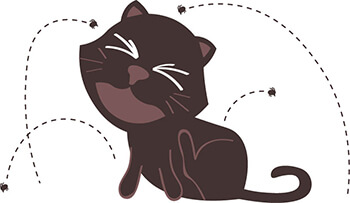
The Great Imposters: Correctly Identifying Symptoms
By Bernadine Cruz, DVM
Symptoms are defined as “a sign or indication, a phenomenon accompanying something and serving as evidence”. Symptoms are not a disease. They are not always specific to a particular condition and frequently masquerade as another.
Some of the greatest imposter symptoms are vomiting and diarrhea, along with itching/biting/scratching. Changes in weight - up or down, and those annoying bumps are but a few of the others that can arise from myriad conditions.
Is it vomiting or regurgitation? Does it make any difference when you still have to clean up the mess? Vomiting takes concerted effort to hurl the contents of the stomach onto your newly cleaned rug…it rarely seems to be on the bare floor. Regurgitation is passive. Your pet may only need to put its head down and the material falls out of its mouth. Regurgitation can indicate a defect in the esophagus, the tube that connects the mouth to the rest of the digestive tract. Diseases such as certain birth defects, cancer, rabies, various muscle diseases, neuropathies, and hernias of the diaphragm can all present with regurgitation.
Vomiting is often preceded by that look of nausea - drooling, lip smacking, worried countenance. Then comes the repeated sucking in of the gut and that sound you made when you ate too much at the county fair and rode the tilt-a-whirl. An occasional bout of vomiting is not uncommon, but when it has been going on for several days, there is blood in the vomitus (it may look like coffee grounds), the pet is weak, has concurrent diarrhea or you see definite signs of foreign material, there is no time to waste. Get the pet to the veterinarian ASAP. Toxins, uncontrolled diabetes mellitus, dietary indiscretion, numerous infectious diseases, and a litany of other maladies can all have you reaching for the floor cleaner.

Itching/biting/scratching by a dog or cat can be due to all the same reasons your skin becomes irritated. Allergies to what a pet sleeps on, steps on, inhales, bathed in, or eats can result in skin irritation, even if it has been exposed to these items for years. Certain hormonal induced conditions can also result in flaking, scaling, and poor hair coats. Where a pets licks or bites itself can assist a veterinarian in determining the cause of the dermal dilemma. Fleas are notorious for causing skin issues. Some pets are so exquisitely sensitive to fleas that it may only take a single bite to set off a vicious cycle of self trauma. Don’t wait until you see fleas before you start treating your pet. Most veterinarians will recommend that you practice year round external parasite control.

Dramatic fluctuations in weight, either up or down, should be cause for concern. Depending on the size of your pet, a pound or two can be a huge change. A 2# weight loss for a 10# cat would be the same as a 120# woman losing 24#. That is equivalent to a loss of 20%. Causes for tipping the scales downward could be dental disease, kidney or liver disorders, diabetes mellitus, an overactive thyroid in a geriatric cat, an increase in exercise, or simply someone in the family forgetting to feed the pet.
Pudgy pooches may attribute their portliness to grandma slipping them too many treats, lack of exercise, hormonal diseases, or cancer. Monitoring a pet’s weight doesn’t require taking it to the veterinarian’s office for a monthly weigh in. If the pet is small enough, jump on your own bathroom scale with and without the pet. You can also use body condition scoring. Gently place your hands on the pet’s ribcage, right after the shoulders; with a bit of pressure you should be able to feel the ribs. If you are pinching an inch, it is over optimum.
Bumps, more times than not when a pet owner makes an appointment for a lump/bump check, in their minds, they have already made the diagnosis. They fear it is cancer. Thankfully, the majority of the time it isn’t the dreaded “C” word. Sometimes it is merely fat - a squishy lump of blubber under the skin. Lipomas can be anywhere on the body. They usually grow slowly and are not painful. A nodule may be an oily gland cyst, a sebaceous adenoma - think of a huge zit! They can rupture and become infected so removal may be needed. As with people, you typically can’t tell if a bump is cancerous merely by looking at it. Obtaining a sample by performing a fine needle aspirate (sucking out some of the cells) or getting a chunk of the mass (biopsy) and submitting it to a pathologist for analysis is the best way to get the most accurate answer.
Though it can be tempting to self diagnose or consult Dr. Google for what ails a pet, resist the temptation. Most veterinarians will gladly conduct a brief complimentary phone consultation with you regarding your concerns. But don’t be surprised if they recommend bringing the pet in for an examination, symptoms can be great pretenders.


